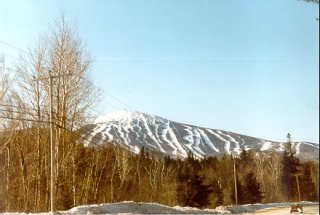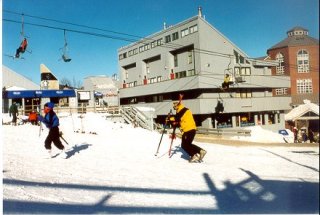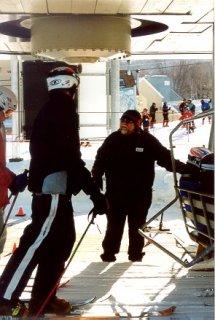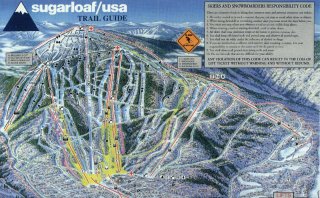Carrabassett Valley, ME – The wind had quieted. The sun
had burned away the early-morning clouds. And when my husband and I slipped
off the Timberline lift, the sign to our left was like a neon EAT ad beckoning
to the starved. It told us that Sugarloaf’s famed Snowfields were open.
n
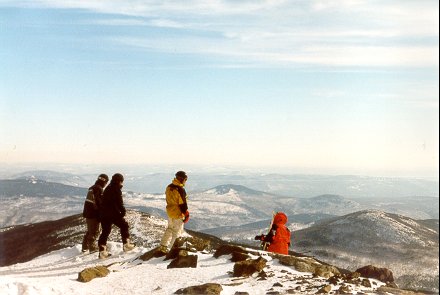 The views from Sugarloaf’s summit are breathtaking. The road to get there is rocky. But skiing down the backside is a blast. |
We clicked out of our skis and headed for the rocks. Then climbed, taking tiny,
unsure baby steps over the jags and ice. We were hiking up a mountaintop in
ski boots, with only skis-in-hand to steady us.
Still more rocks and more ice. I was hot from the hard work.
Until, finally, the glorious summit. Three-hundred-sixty degree views of rock
and forest. Mt. Katahdin was to our left. Mt. Washington, to our right. We stood
above the clouds and looked out at the vista. No wonder Amos Winter had picked
this peak when he got the jones for skiing half-a-century ago.
But soon it was time to quit admiring, time to do what we had come here for.
I popped on my Rossis, said a quick prayer and pointed my body downhill.
Turn. Turn.Turn. Stop and look back at where you were.
We were among the first skiers down on this morning. The snow was deep from
the generous heaping of white stuff Mother Nature had decided to dump on Maine
in the previous few weeks. Just a thin coating of ice on top kept the conditions
from being to-die-for.
But I certainly wasn’t complaining. We skied what felt like was out, into the
blue, blue sky, rather than down. No trail or map to guide us. Just the half-obscured
tracks of an earlier days’ adventurers. And all the obstacles of a mountain.
We skied around rocks, under trees. We turned hard and dug in fast. I tumbled
on the steepest part. But when standing, skiing, wind whipping my hair, I wanted
to shout.
Wow. It was just so beautiful.
It kicked our butts.
|
|
This was why we had come to Sugarloaf. Sugarloaf isn’t just a mountain. Or
a ski resort. It’s a beloved institution, with history and traditions, legends
and a loyal following. On this, its 50th anniversary, that couldn’t be clearer.
Sure, Sugarloaf’s got every up-to-date amenity a skier could want. It’s got
that new hotel just steps from the slopes. Fine dining. A hive of condos, most
of them ski in/ski out. Hot tubs. A tubing park. Snowshoeing. Ski lessons. A
first-rate golf course in the summer.
But there’s a Sugarloaf feel that sets it apart from any old ski resort. It’s
a little bit rugged, a little back-to-basics. The pervasive mood is: If you’re
not a serious skier/rider, this isn’t the place for you.
The village, for example, is no Rodeo Drive. It’s just a one block stretch
of mostly ’70s style barracks-like buildings. The bands in the bars are local
folks, the kind that play every weekend. There’s less glitz than Whistler/Blackcomb.
Less see-and-be-seen than Aspen.
You can’t be at Sugarloaf long before realizing this mountain community hasn’t
strayed far from its roots. Which are about as deep as any resort in the U.S.
It was 1950 when local general store owner and ski aficionado Amos Winter cut
the first trail at Sugarloaf Mountain. He had been skiing in the area for decades
and teaching his passion to the local kids, some of whom came to be called the
Bigelow Boys for skiing down Bigelow Mountain.
But after the power company flooded the town of Flagstaff — and cut off Winter
and the boys’ access to Bigelow — they were in search of another place to ski.
That’s when Sugarloaf became their new destination.
The resort opened in the winter of ’51, and the just formed Maine Ski Council
took interest immediately. Boosters called it the best mountain in Maine. Time
proved them right.
Through the decades, Sugarloaf improved and grew. By 1966, the base-to-summit
Gondola was built. In the ’70s, came the condos, the village, the first World
Cup Downhill and Slalom races. Snowmaking and grooming equipment became a priority
in the ’80s. A snowboard halfpipe and alpine parks were built. In the 1990s,
the Sugarloaf Superquad replaced the Gondola, which had been closed too often
due to the mountain’s infamous winds.
Every few years, a few more trails. A few more condos. A few more competitions.
But with all the change, one thing stayed the same: The emphasis of Sugarloaf
was always about the skiing and riding. And the people who partook of the sports.
Over the years, Sugarloaf has attracted a huge following of loyal skiers. Lift
operators, like Dennis Parsons, came to work and ski and stayed for 36 years.
Sugarloaf’s vice president of mountain operations began as a snowmaker and worked
his way up. Every employee wears a badge that proclaims: Sugarloafer since 1972
or whatever year they first skied the mountain.
Today, Sugarloaf boasts more than 126 trails and glades on 530 acres. Another
870 acres are available for boundary-to-boundary skiing and riding. Fifteen
lifts can transport 21,000 skiers per hour. It’s a magnitude Amos Winter couldn’t
have dreamed of.
Yet, in all the best ways, Sugarloaf still feels like a resort from an earlier
time. But if Sugarloaf’s people and village are laid-back and welcoming, the
mountain is another story. Up there, nature’s in charge. And no one’s ever quite
sure what she’s got up her sleeve.
Sugarloaf climbs 2,820 feet, measuring more than 4,200 feet at its peak. When
the wind blows, it can whip. When the snow falls, it can dump.
In the three weeks before my husband and I flew in, Sugarloaf had received
nearly six feet of snow; the weekend before we got there, the winds had blown
so strong the entire resort had to be shut down. No groomers went up on the
mountain for two days. No skiers, no nothing.
We hit the slopes on a Thursday morning, after two or three inches of snow
had fallen the night before. The resort had had plenty of time to get to the
groomed trails by then and the blues and greens at the bottom of the mountain
were easy, cruiser runs. There’s a lot of space for beginners and intermediates
at Sugarloaf. And on nonholiday weekdays, there are no crowds to speak of.
It wasn’t long before we hit the Sugarloaf Superquad and tested the many runs
off it. Skidder’s a great bump run. Upper Double Bitter is a tight, fast trail
that was a blast. Sheer Boom was completely ungroomed, making for some nice
powder and good moguls.
On our first day, it was tricky to get over to the Eastern side of the mountain,
as the King Pine lift was closed due to high winds. But we managed. And, boy,
were we rewarded for our efforts.
The tendency is to stick to the superquad: It’s fast, it’s almost always open
and there are lots of good trails off it. But nothing like Bubblecuffer.
Bubblecuffer is a narrow, steep run that when we encountered it offered up
some of the best snow on the mountain. It was deep. On the lefthand side, it
was possible to get that great floating feeling that typically comes only on
a fresh powder day. This, a full week after Sugarloaf had actually gotten the
freshies.
To stay on the Eastern part of the mountain, we took the Spillway chair to
the Spillway Crosscut and had our pickings from there: Upper Winter’s Way (which
was blown off and a little icy), Bubblecuffer, Boomauger (Lower Boomauger was
another trail with really incredible snow), Ramdown and all the way over, Ripsaw.
On Ripsaw, there were actual drifts, mountains of snow that had blown up along
the trail. We loved it. No one else was even on it. We made it our last run
of the day.
Then, on Friday, we realized it wasn’t supposed to be like this.
“Where are all the bumps?” asked Cheryl Fullerton, the Sugarloaf communications
manager that was showing us around this morning. “Normally Bubblecuffer, Ripsaw,
all these are huge bump runs.”
Turns out, all that wind after all that snow had completely altered the terrain
on this side of the mountain. The bumps had filled in. All that was left was
that divine, deep snow. Shows you how much a mountain is like a river, constantly
changing, ever elusive. Cheryl couldn’t get over how much these trails were
NOT supposed to look like they did. But we had a great time on these newly non-bump
runs. Widowmaker and Choker and Wedge. Friday was warm, with little wind, so
King Pine chair was open. And it was easier to spend all day on these trails.
These, and the Snowfields.
Friday was the day we took on Sugarloaf’s top challenge. We didn’t exactly
win, but we were better for trying.
The backside of the Snowfields — they call it High Rigger though there is no
set trail — was much better skiing than the front side. The front offers more
traditional trails: long, marked drops down the mountain face. We tried White
Nitro Extension, the run with the steepest pitch on the mountain. It was steep.
And icy. And not really any fun.
By Sunday, we felt like we knew the mountain. Man, were we wrong.
We began on Timberline, over on Sugarloaf’s West. The winds were brutal, though,
and they chased us Eastward. We played on Skidder, then Bubblecuffer and Winter’s
Way, for awhile. But the bumps were re-forming, making these runs a lot different
(make that harder) than they’d been even just the day before.
We were ready for something new. That’s when we decided to tackle the glades.
We’d had trouble finding them throughout the weekend and had basically given
up. The one we saw seemed downright claustrophobic; too scary for the likes
of me. But by Sunday, even I was game. So my husband and I shot into Rocky Road,
just off the Lombard Crosscut, and began to take our lumps immediately.
Sugarloaf’s glades are not the thinned, mountainwide tree runs I had taken
on in the West. Here, there was little room for forgiveness and lots and lots
of trees. These glades were fast, too. And if you fell and had to take off your
skis, God help you. We sank into the snow up to our thighs more than once, trying
to stand enough to re-enter our skis. But you know, those glades were some of
the most fun trails I ran all weekend.
Once we went down Rocky, the other glades began to appear out of nowhere. Just
below Rocky Road was another glade, a little less steep, that we ran two or
three times. Then, when the lifts started closing, again because the winds were
kicking up, we moved over to Whiffletree Superquad and picked up the Boomer
Glade off it.
I’ll never get used to how silent it can be in the trees. The late daylight
was gorgeous. And there, we were sheltered from what was becoming a harsh wind.
As we took our last lift up, I knew I was going to be sad to leave this place.
Sugarloaf had treated us right. From the Snowfields to the cruiser runs to the
moguls to the incredible snow to the glades, we’d seen everything on the slopes.
And from good food to good sleep to low-key lingering, the village had struck
a great chord.
We loved it so much, I know we’ll be back. And next time, I’ll get to say:
Sugarloafer since 2001.

